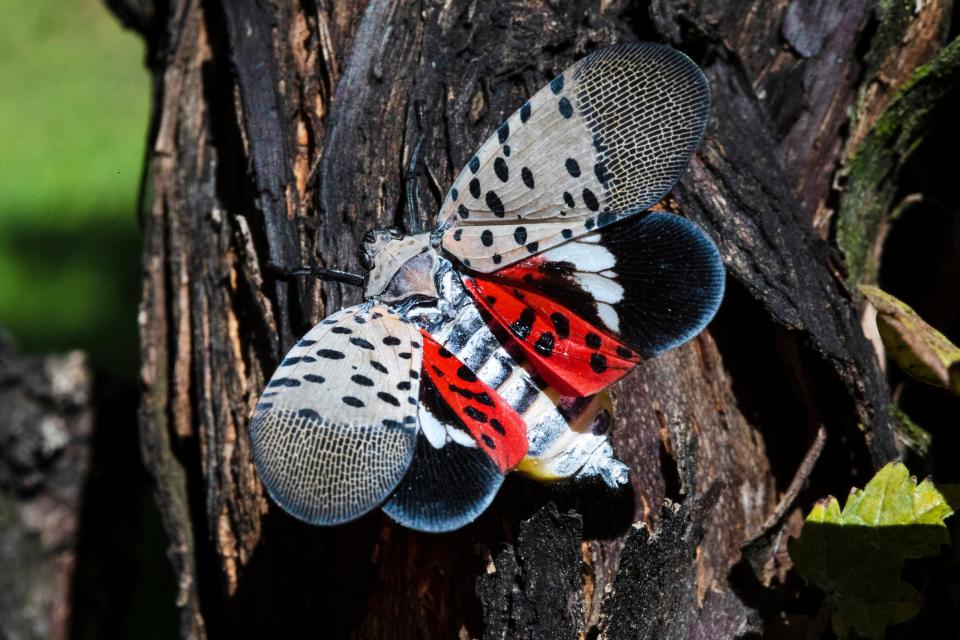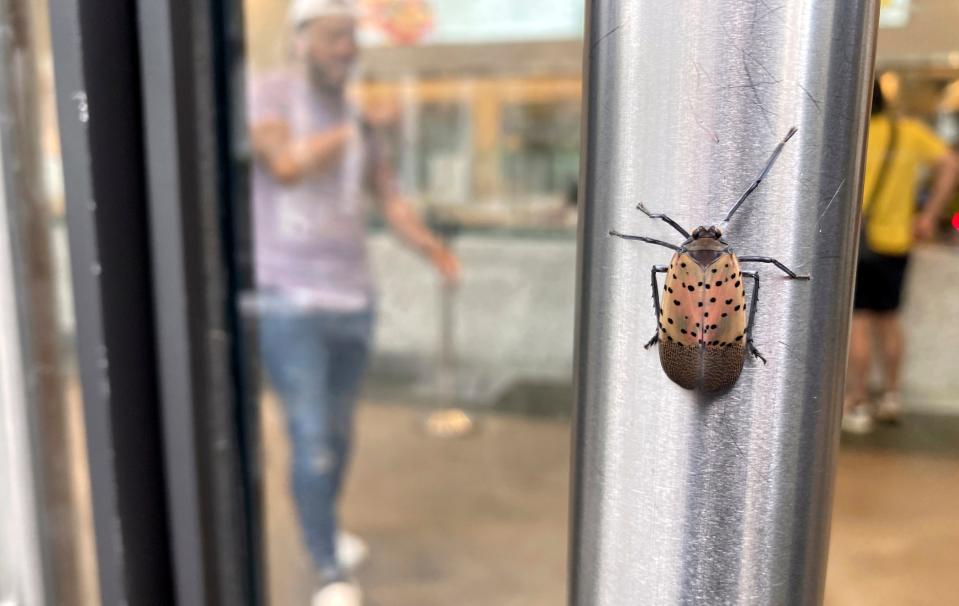Invasive spotted lanternflies emerging in Lower Hudson. What's being done to kill them?
Have you seen the spotted lanternfly — brightly colored, long-legged and, yes, covered in black spots?
If you haven't come across this invasive bugger, you probably will. The plant-sucking insect has become far more common in Rockland and lower Westchester this summer and is headed north over the next year or two.
Adults have started to emerge in recent weeks from the developmental "nymph" stages and are drawing a lot of attention in Yonkers, Scarsdale and surrounding communities, as well as on social media.

"It's jarring, because you won't see one or two, but hundreds or thousands," said Hillary Jufer, a Rockland resident and Westchester-based horticulture program manager for Cornell Cooperative Extension. "People don't know what they are. It's a hot topic, for sure."
Limiting the spotted lanternfly's spread
Municipal parks people and professional bug-trackers have been keenly focused on containing the spotted lanternfly since the species, native to China, arrived in the U.S. in 2014. They will attack a variety of crops, including grape vineyards, which are big business in New York. They don't bite and are harmless to people.
Adult spotted lanternflies like to feed on the tree of heaven, which are plentiful in the Lower Hudson Valley, especially in former areas of construction where people tend to congregate, like parks. The insects tend to travel and find new areas to lay eggs by latching themselves to the undersides of cars and trucks.

Lots of efforts have been underway to keep the spotted lanternfly in check, including the use of high-powered vacuums to suck them up and conservation dogs to sniff them out.
"There's been a lot of work to slow the spread in New York state and we've been successful in doing that," said Brian Eshenaur, a leading expert on the spotted lanternfly as a senior researcher on invasive species for Cornell University's Integrated Pest Management Program.
"That doesn't mean it won't spread," he said. "But it's buying us time to allow more research to get a handle on safe ways to manage the pest and protect agricultural crops, particularly grapes."
Natural predators may slow insect's growth
Some good news, Eshenaur said, is what's been learned in Pennsylvania, where the spotted lanternfly appeared in 2014 and devastated certain crops, including grape vineyards. The rise of several natural predators, like the praying mantis, spiders, wheel bugs and birds, as well as fungi naturally building up in the environment, have cut way back on the insect's spread and the damage done.
"They were not a species of concern in Asia, but were released from their natural predators when they came here," Eshenaur said. "But now in Pennsylvania, insects are keeping them in check, fungi are building up and birds are figuring out they're a food source."
"This is an insect we will have to learn to live with, but their numbers will come down," he said.
More: They're here: Spotted lanternfly makes its way to the Hudson Valley
In New York, the spotted lanternfly first popped up on Staten Island in 2020 and started hitching rides north. Substantial numbers have been spotted in Orangeburg, Tappan and Valley Cottage and across lower Westchester. Large infestations were found in Tibbetts Brook Park in Yonkers and by the Bronx River Parkway in Scarsdale.
The expectation is that they'll be in northern Westchester in a year or two.
"We wait for them to become adults and try to get them before they lay their eggs, which is from now to October," said Taro Ietaka, conservation supervisor for the Westchester County Parks Department. "We want to reduce the number that will hatch next year. The wave has not fully arrived here, but we can hold it down the most we can, as long as we can."
How to get rid of spotted lanternflies at home? Vacuums are a start
Westchester has purchased five cordless, backpack vacuums that are being used to suck up the bugs at Tibbetts Brook Park, Glen Island Park in New Rochelle, Saxon Woods Park in White Plains and elsewhere. One was loaned out to the village of Hastings-on-Hudson.
Officials say that when residents find the insects on or near their homes, they should use vacuums or power washers to remove them. The eggs, which look like lumps of putty, can be scraped off trees or other locations and put in trash bags.
A bunch of home remedies suggested on social media, like the use of vinegar or soap, won't work, Jufer said. "They may harm plants, but won't kill the spotted lanternfly," she said.
Jim McHale, president and CEO of Buchanan-based JP McHale Pest Management, said he's hearing from a lot of consumers who are alarmed by the mysterious insect's bright colors.
"They are a little frightening, but the color scheme is a defense mechanism to keep birds away," he said. "I'm seeing a tremendous amount in Yonkers, Scarsdale, Bronxville. They're not good flyers, but tend to travel when their egg nests get on cars and other equipment."
McHale said he sprays Neem oil, a naturally occurring pesticide, to kill both nymphs and adults.
He urged people to be diligent about spotting egg masses and removing them. "They look like smears of mud," he said. "Scrap them and bag them. It benefits everyone."
This article originally appeared on Rockland/Westchester Journal News: Invasive spotted lanternflies emerging in Lower Hudson. What to know

